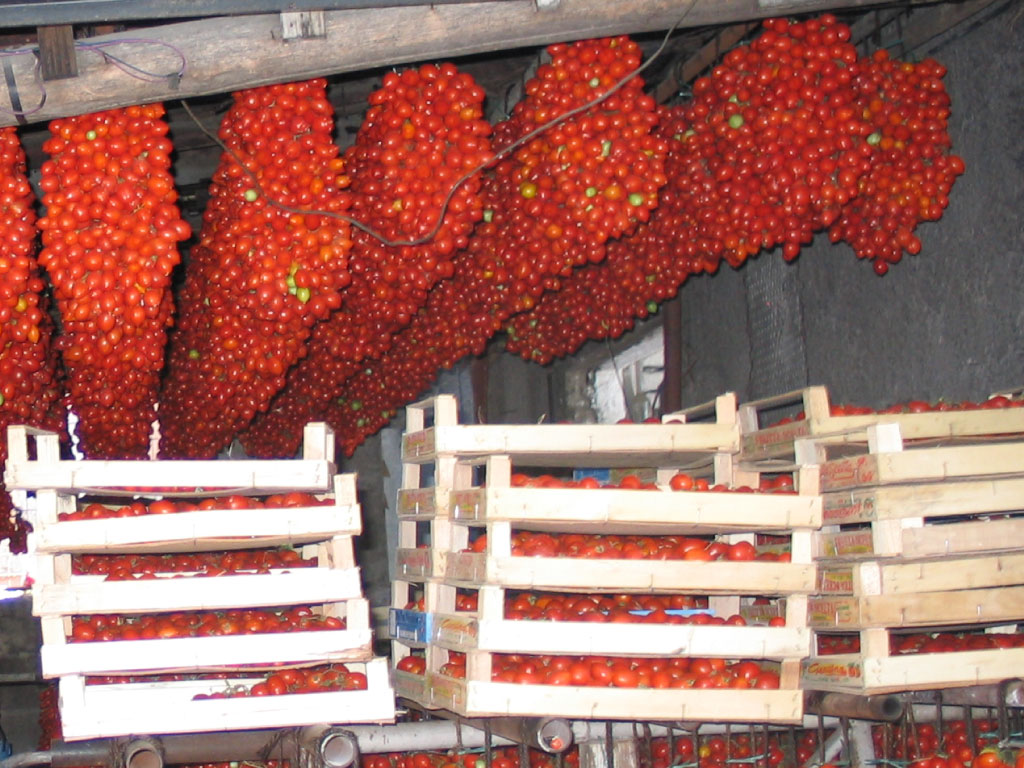The cultivation of the Piennolo tomatoes on the slopes of Mount Vesuvius undoubtedly has ancient and well-documented roots. Just considering the most illustrious historical testimonies, news on the product are reported by Bruni, in 1858, in his “Of the vegetables and their cultivation near the city of Naples”, where he talks about cherry tomatoes, so tasty that “they are good until spring, as long as they are hung up in bunches tied with hemp string”.
Another reliable literary source is that of Palmieri, where in the Yearbook of the Royal High School of Agriculture in Portici (current Faculty of Agriculture) of 1885 he talks about the practice in the Vesuvius area to preserve the berries of the variety “p'appennere” in shaded and ventilated places.
Francesco De Rosa, another professor of the School of Portici, in “Italy Orticola” of November 1902 specified that the old Vesuvius “cerasella” had been gradually replaced by the "flask" type, more suitable for the conservation of tomatoes.
De Rosa is also the first researcher who exhaustively reports the entire cultivation technique of Vesuvius tomatoes, thus suggesting that an entire economy was developing in this area around this product, from the production of seed plants to the sale of the preserved product.
Marzio Cozzolino, professor of the Faculty of Agriculture of Portici, in his text of 1916 agrees with the previous sources, both on the varietal description and on the production methods, dedicating entire parts of the text to minutely describe the cultivation technique and above all supplying data, also economic ones, which help understand the industriousness and complexity of this type of product.
Production area
The typical area of production and conservation of the Piennolo cherry tomatoes coincides with the entire extension of the Somma-Vesuvius volcanic complex, from its slopes to the sea level.
In particular, the area of production and conditioning required by the specification of Vesuvius Piennolo tomatoes DOP includes the entire territory of the following municipalities in the province of Naples: Boscoreale, Boscotrecase, Cercola, Herculaneum, Massa Di Somma, Ottaviano, Pollena Trocchia, Portici, Sant'Anastasia, San Giorgio a Cremano, San Giuseppe Vesuviano, San Sebastiano al Vesuvio, Somma Vesuviana, Terzigno, Torre Annunziata, Torre del Greco, Trecase, the part of the territory of the municipality of Nola bounded on the perimeter: from the provincial road Piazzola di Nola - Rione Trieste (the area that goes by the name of "Costantinopoli"), from “Lagno Rosario”, from the border of the municipality of Ottaviano and that of the municipality of Somma.
Description
Vesuvius tomatoes are appreciated on the market both for their fresh state, sold as soon as they’re harvested on the local markets, and for their typical form of preservation, either hung up in bunches tied with hemp string - “al piennolo” - or even as a glass preserve, following an old family recipe of the area, called “a pacchetelle”, to which the DOP production specification also refers.
Tomatoes are harvested by cutting the whole bunches, when there are at least 70% of red tomatoes on them, while the others are ripening. This ancient practice allows to postpone the consumption of berries, which stay intact and unchanged throughout the winter following the harvest, up to seven to eight months, using ventilated rooms and without the support of modern conservation technologies.
The peculiarities of the Vesuvius Piennolo tomatoes are the high consistency of the peel, the strength of hanging on the peduncle, the high concentration of sugar, acids and other soluble solids that make it a long-life product and none of its organoleptic qualities undergoes alterations. These peculiarities are deeply linked to the pedoclimatic factors typical of the geographical area in which the tomatoes are cultivated, where the soils of volcanic origin are made of pyroclastic material originating from the eruptive events of the Somma-Vesuvius volcanic complex.
In this environment, the quality of the tomatoes reaches peaks of excellence. Just the richness in organic acids determines the liveliness or acidity of taste, which is the distinctive characteristic of the tomatoes of Mount Vesuvius. This, in addition to deriving from a genetic peculiarity, is indicative of a method of cultivation with low environmental impact and with reduced use of irrigation water, which makes this crop particularly suitable for a protected area, such as that of the Vesuvius National Park.
For all these reasons, the Vesuvius Piennolo tomatoes represent a fundamental ingredient of Neapolitan and Campania cuisine in general, and have a great versatility in the kitchen. Besides the traditional spaghetti with clams and other seafood, local chefs are committed to using it in many other dishes, including a variant of the delicious Neapolitan pizza.
Seasonality of the product: it’s harvested in summer.

